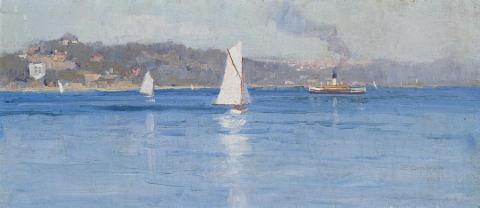ARRIVAL OF THE FERRY, 1912
Elioth Gruner
oil on canvas on board
15.5 x 34.5 cm
signed and dated lower right: E. GRUNER / 1912
Deutscher Fine Art, Melbourne, 1979
Private collection, Sydney
Sotheby's, Sydney, 23 – 24 May 1999, lot 634, as 'Sydney Harbour'
Martin Browne Fine Art, Sydney
Private collection, Sydney
Society of Artists' Annual Exhibition, Sydney, 20 November 1912, cat. 10
Probably, Private View of Pictures by Notable Australian Artists, and a Small Collection of Antiques, Fine Art Society, Melbourne, 16–31 December 1912, cat. 20, as 'The Ferry' Nineteenth and Twentieth Century Australian Art, Deutscher Fine Art, Melbourne, 12 July – 18 August 1979, cat. 54, as 'Sydney Harbour', (illus.)
Since the arrival of the artists of the First Fleet, Sydney Harbour has attracted countless artists through its sheer beauty and sweeping grandeur, a marriage of sparkling waters and majestic promontories. It has been painted so many times that an indifference to the subject could be forgiven. But, in the hands of Australia's finest Impressionists, first Arthur Streeton and later Elioth Gruner, the wondrous spectacle that the Harbour offers is matched by a talent that conjures up images that enthral the eye. Such a work is Gruner's Arrival of the Ferry. The harbour ferry is a common enough sight for a Sydneysider, as are the reflections of white sails in placid waters, and the lazy upward drift of the ferry's smoke. Yet, through the singularity of Gruner's brush strokes, each engenders a captivating mood of indolence. To see the ordinary and represent it with such lyrical beauty is part of the magic of art, as the artist draws upon nature to create his own illusion of atmospheric splendour. Arrival of the Ferry was included in the 1912 Society of Artists annual exhibition, described by the art critic for the Sydney Morning Herald as 'one of the strongest seen for years.'1 'Mr. E. Gruner's coast scenes' he wrote, 'show many fine qualities. The encircling blue sea at 'The Spit', the atmosphere, and the perspective all contribute to the making of a good picture; and the little scenes at Bondi and at Bronte, with the minute figures on the ocean's verge beyond the wide expanse of sand, suggest the manner of Conder.' The following year, in 1913, Gruner included the large canvas, Spring Morning, Sydney Harbour in the annual exhibition of the Society of Artists. It was described as 'a hit', being admired for 'its expression of an exquisite serenity and placid calm on sea and land and sky - pale blue water lapping on receding shores, and a quite recognisable 'atmosphere' characteristic of the season and the situation.'2 Though much smaller in size and under a later sun, Arrival of the Ferry has that same touch of bravura only on a more appealing, intimate scale.
While Gruner went on to make his reputation as a master of the painting of light, it was more often the early brightness of a spring day, of frosty mornings and silvery autumn lights that won him such acclaim. His first two Wynne Prizes of 1916 and 1919 were for Morning Light and Spring Frost. The Arrival of the Ferry , 1912, Figures at Coogee 1913, and companion works, however, represent those first enthusiastic outpourings of a highly gifted artist in which nature sparkles through his assured technique.
1.'Society of Artists. The Best Show for Years', Sydney Morning Herald, 10 November 1912, p. 20
2. 'Society of Artists. Annual Exhibition', Sydney Morning Herald, 22 November 1913, p. 4
I AM ESPECIALLY GRATEFUL TO STEVEN MILLER, ART GALLERY OF NEW SOUTH WALES, FOR HIS GENEROUS SCHOLARLY ASSISTANCE IN THE IDENTIFICATION OF THIS WORK AND FOR FURTHER CATALOGUE DETAILS. STEVEN IS PREPARING A CATALOGUE RAISONNE ON THE WORKS OF ELIOTH GRUNER.
DAVID THOMAS
